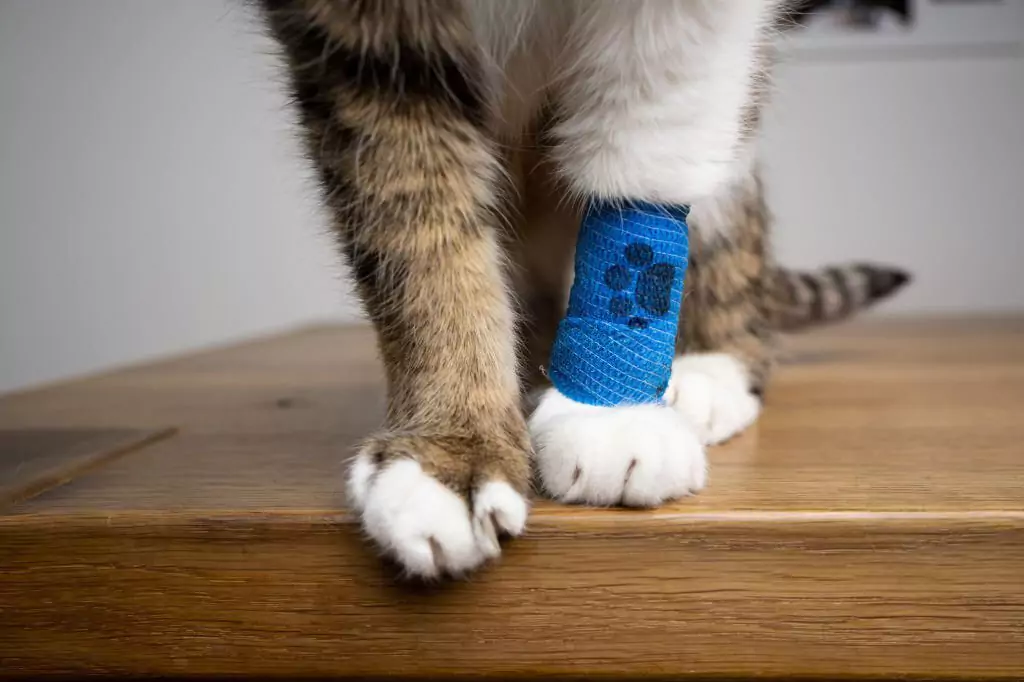Introduction
Proper bandaging techniques are essential for cats recovering from injuries or surgeries. However, if the bandage is too tight, it can cause swelling and other complications. In this article, we will discuss the causes of swelling from tight bandages on cats, the signs and symptoms to look out for, and how to safely remove the bandage. We will also provide tips for reducing swelling and preventing it from happening in the first place.

Understanding the causes of swelling from tight bandages on cats
Tight bandages can cause swelling in cats by restricting blood flow and lymphatic drainage. This can lead to a buildup of fluid in the affected area, causing it to become swollen and painful. The type of bandage used and the length of time it’s been on the cat can also contribute to swelling. For example, a bandage that is too tight or left on for too long can cause more swelling than a properly applied and regularly changed bandage.
Signs and symptoms of swelling in cats with tight bandages
The signs of swelling in cats with tight bandages can vary depending on the location of the bandage. Common signs include redness, warmth, and pain. You may also notice that the affected area feels firm or puffy to the touch. To check for swelling, gently press on the area with your finger and see if it leaves an indentation. If it does, this is a sign of swelling.
The importance of addressing swelling in cats with tight bandages
Leaving swelling untreated can lead to further complications, such as infection and tissue damage. It’s important to monitor the cat’s condition and seek veterinary care if necessary. Your veterinarian may recommend removing the bandage and treating the swelling with cold compresses or medication.
How to safely remove a tight bandage from a cat
To safely remove a tight bandage from a cat, start by cutting the bandage with scissors. Be careful not to cut the cat’s skin or fur. Once the bandage is cut, gently unwind it from the cat’s limb or body. If the bandage is stuck, use a small amount of warm water to help loosen it. Avoid pulling or tugging on the bandage, as this can cause further injury or discomfort to the cat.
Applying cold compresses to reduce swelling in cats
Cold compresses can help reduce swelling in cats by constricting blood vessels and reducing inflammation. To apply a cold compress, wrap a bag of frozen vegetables or a cold gel pack in a towel and place it on the affected area for 10-15 minutes at a time. Be sure to wrap the compress in a towel to avoid direct contact with the cat’s skin, which can cause frostbite.
Using natural remedies to reduce swelling in cats
Natural remedies such as aloe vera and chamomile can help reduce swelling in cats. Aloe vera has anti-inflammatory properties, while chamomile can help soothe irritated skin. However, it’s important to use these remedies with caution and under the guidance of a veterinarian. Some natural remedies can be toxic to cats or interact with other medications.
Over-the-counter medications for reducing swelling in cats
Over-the-counter medications such as aspirin and ibuprofen can be used to reduce swelling in cats. However, these medications can have side effects and should only be used under the guidance of a veterinarian. Never give your cat medication without first consulting with a veterinarian.
When to seek veterinary care for swelling in cats with tight bandages
If the swelling does not improve or gets worse, it’s important to seek veterinary care. Your veterinarian may recommend removing the bandage and treating the swelling with medication or other therapies. In some cases, surgery may be necessary to address the underlying cause of the swelling.
Preventing swelling in cats with proper bandaging techniques
Proper bandaging techniques can help prevent swelling in cats. Be sure to use the correct type of bandage for the injury or surgery, and apply it snugly but not too tight. Check the bandage regularly and change it as needed to ensure that it remains clean and dry.
Tips for monitoring and managing swelling in cats with tight bandages
To monitor and manage swelling in cats with tight bandages, keep the affected area clean and dry. Check the bandage regularly for signs of swelling or other complications. If you notice any changes in the cat’s condition, seek veterinary care immediately.
Conclusion
Reducing swelling from tight bandages on your pet cats is essential for their recovery and overall well-being. By understanding the causes of swelling, recognizing the signs and symptoms, and taking steps to prevent and treat it, you can help your cat heal and avoid further complications. Remember to always seek veterinary care if you have any concerns about your cat’s health.


